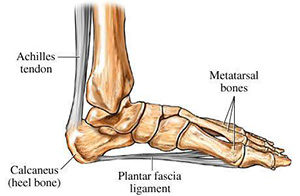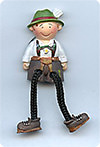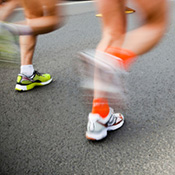
Runner's Guide On How To Prevent Plantar Fasciitis
Posted on 16 Apr, 2019

Whatever does not kill you, makes you stronger. Except when it comes to plantar fasciitis. Unlike muscles, which get stronger through a process of damage and repair, plantar fasciitis gets progressively worse each time.
The plantar fascia is a tendon, and tendons work best when they are supple. Each time you injure your plantar fascia, micro-tears occur. Your body will naturally heal itself, but the resulting scar tissue will be hard. This will make your plantar fascia less flexible than before and even more prone to injury.
So prevention is the only cure.
Some Background
 Plantar fasciitis is inflammation of the plantar fascia, a band of connective tissue that stretches from your heel bone to the base of your toes. This tissue supports your foot’s arch, and provides cushioning and stability when you walk or run. This tendon also allows you to point your toes.
Plantar fasciitis is inflammation of the plantar fascia, a band of connective tissue that stretches from your heel bone to the base of your toes. This tissue supports your foot’s arch, and provides cushioning and stability when you walk or run. This tendon also allows you to point your toes.
Inflammation of the plantar fascia is usually caused by motion of the legs that pulls excessively on the plantar tendon.
Proper Calf and Achilles Stretches
Although the pain from plantar fasciitis is in the foot, the problem is usually caused by your calf and Achilles muscles being too tight. Before you go for a run, it is crucial that you get these stretched out. Here’s a video of the three most essential stretches for PF to loosen those areas.
Kick Start Your Foot’s Circulation
To get blood flowing to your feet, do toe scrunches and ankle pumps. Soaking your feet in warm water for 10 minutes also helps relieve any stiffness. To further loosen the fascia, roll a tennis or golf ball back and forth under each foot for a few minutes.
Relax Your Lower Legs While Running
 Many of us take our running very seriously, but we go about it in the wrong way. We blast our power jams through our headphones and go blow for blow with the pavement. But watch the pros and notice how they remain loose all the way through the end. Tension held anywhere in your legs or glutes will pull on the Plantar tendon when you move. Don’t force your stride. Flow into it.
Many of us take our running very seriously, but we go about it in the wrong way. We blast our power jams through our headphones and go blow for blow with the pavement. But watch the pros and notice how they remain loose all the way through the end. Tension held anywhere in your legs or glutes will pull on the Plantar tendon when you move. Don’t force your stride. Flow into it.
Land Midfoot
Tremendous pressure is put on your Achilles when you heel strike, and this pressure is transferred on to the plantar fascial membrane under your foot. A great way to learn how to land midfoot is to incorporate minimal running into your routine. When you run with minimal footwear, you will have no choice but to land on the meaty part of your foot, which is in the middle. Overtime, your body will be conditioned to run this way. By running midfoot, your plantar tendon is relaxed through the landing and will be less likely to get inflamed.

Use Gravity To Your Advantage
 To get extra propulsion, many of us claw forward with our feet. This is alright for short runs, but on a long run, the burden can be too much for your feet to bear.
To get extra propulsion, many of us claw forward with our feet. This is alright for short runs, but on a long run, the burden can be too much for your feet to bear.
Efficient distance running takes the form of forward falling and is renewable, the legs and feet acting as springs that transfer the energy from one fall into the next, into the next. To run in this fashion, incorporate a slight forward lean from the ankles, shorten your stride, and minimize the time your feet stay on the ground by increasing your cadence. When you do this, you minimize impact with the ground, and you conserve both your energy and your legs.
Photo Credits
Strength Conditioning For Runners

by Peter Magill

by Jay Dicharry

by Kelly Starrett

by Jeff Horowitz

 Are You Running Too Much?
Are You Running Too Much? 8 Ways To Speed Up Muscle Recovery
8 Ways To Speed Up Muscle Recovery A Guide To Buying The Right Running Shoes
A Guide To Buying The Right Running Shoes Core Workouts For Running
Core Workouts For Running










